

| Home | For sale | Site map | Contact information | Guest book | Stielhandgranate 24 menu |
 Stielhandgranate
24 bits & bobs Stielhandgranate
24 bits & bobs  |
|---|
|
Odds and ends relating to the Stielhandgranate 24 When researching the Stielhandgranate 24 I stumbled across quite a few "aspects" of the hand grenade that really didn't fit in with the chosen themes for the articles. And each of these "aspects" were too small or narrow to write about on their own. So this is the virtual "junk box" for all those bits & bobs! Destruction of duds The 1936 dated manual "Die Stielhandgranate 24 und ihre Handhabung" has a special chapter on destruction of duds during peace time hand grenade training.  In short: Wait 15 minutes before you approach the dud. Should be destroyed by a blast, performed by a Feuerwerker or specially trained officer. Up to 5 Stielhandgranate 24 could be destroyed at one time by placing them in a 1 meter deep hole. All heads must be placed together, and the detonation started with a block of explosives placed in the middle. The fuse should be 1,5 meter long (standard burning time for a fuse is 1 cm / second, so the man igniting the fuse would have 150 seconds to reach cover). If there are no extra explosives and fuse present at the range, an alternative method could be used. Collect the duds and make a Geballte Ladung, but leave the handles undisturbed. Throw it like a normal Stielhandgranate 24, but ensure that good cover can be found (!). Official nomenclature The Stielhandgranate 24 and all its associated equipment and parts were listed in a official (but secret) list that included all German weapons and equipment in use. It was simply called "D 97/1 Gerätliste".  It listed all items in use by the German army at the date of publication. I have edited the pictures so that only the items of interest to this article are included, but I have kept the headlines so that the eager reader can see which category the individual item fell under. The only items I haven't been able to find are the Einsatz, the interior rack for the steel suitcase, and the Übungsladung 30. The most interesting information is the official abbreviation (Kurzbenennung) for each item.  "Nahkampfmittel" - Close combat equipment. There is only one type of fragmentation sleeve listed, so the two models must have been regarded as equal by the supply system. The Stielhandgranate 43 was by 1.7. 43 not in the supply system yet, so it was not listed.  "Mechanische Zünder" - Mechanical igniter  "Sprengkapseln" - Detonators  "Lehr- und Übungsgerät" - Training and practice equipment The training hand grenade was listed complete with the igniter and training charge.  "Kasten, Behälter, Einsätze" - Boxes, containers and inserts Both the steel and wooden box was listed, but the internal rack for the steel box was not listed as a separate item. Training aids The Übungs-Stielhandgranate 24 was the official training aid for would-be Stielhandgranate 24 throwers. It used a similar firing mechanism and had the same weight, so it was ideal to simulate the real thing. But the para-military units outside the Wehrmacht wanted in on the action as well, and this created a market for "civilian hand grenade training aids". Both for pure throwing exercises and with a small charge to simulate a detonation. These were sold as sporting requisites. Several models were available on the market. 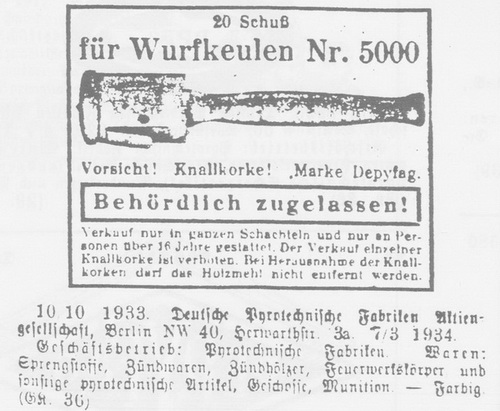  Pictures courtesy of Vidar Andresen  A commercial Stielhandgranate for training. The iron branded "ges. gesch" is an abbreviation for "Gesetzlich geschütz" which means protected by law, patented or copyrighted.  As the only manufacturer from the outset, Richard Rinker also manufactured cut-through models mounted on cardboard for instructional use. Three different models were made (to my knowledge).  Picture courtesy of Tighe, USA 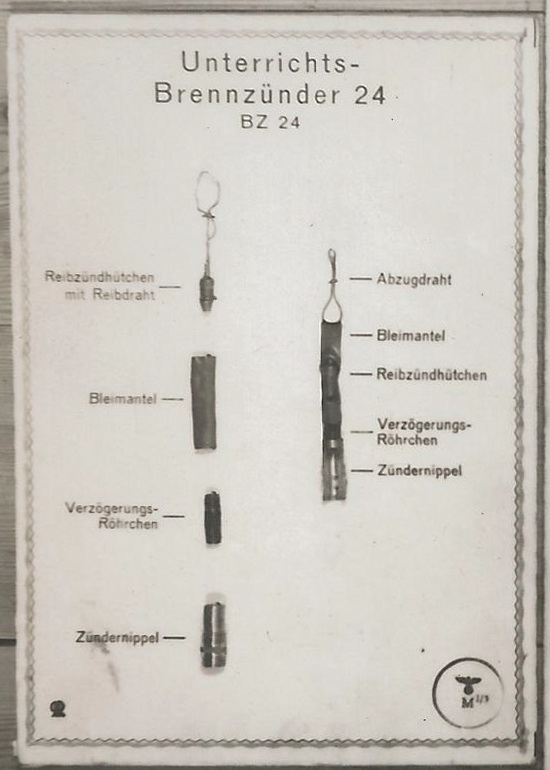 Picture courtesy of Tighe, USA Note the Richard Rinker logo in the lower left corner. The eagle in the lower right corner is a more unusual naval (Marine) property marking. Manuals The Stielhandgranate 24 was described in a variety of technical manuals and pamphlets, as can be seen on the Manuals for the Stielhandgranate 24 page. But it also appeared in several tactical manuals 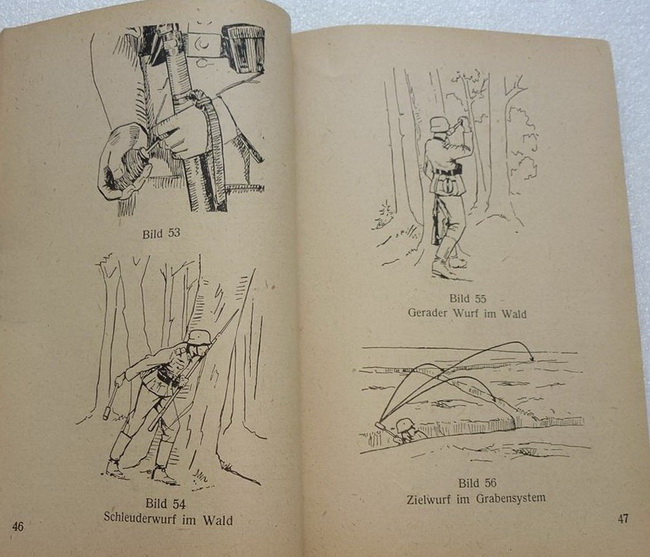 Merkblatt 25/3 Anleitung für den Nahkampf und die Handgranatenausbildung This manual was primarily about close combat, but also incorporated a section on hand grenade throwing and shooting from horseback (!) 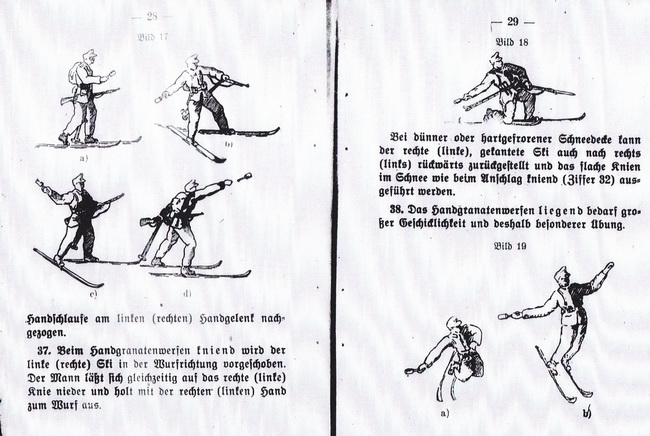 The manual "Merkblatt 25a/19 Vorläufige Richtlinien für Ausbildung und Kampf von Skitruppen" was all about military cross-country skiing. It featured a chapter on hand grenade throwing while on skis. Handgranaten-Sturmtornister 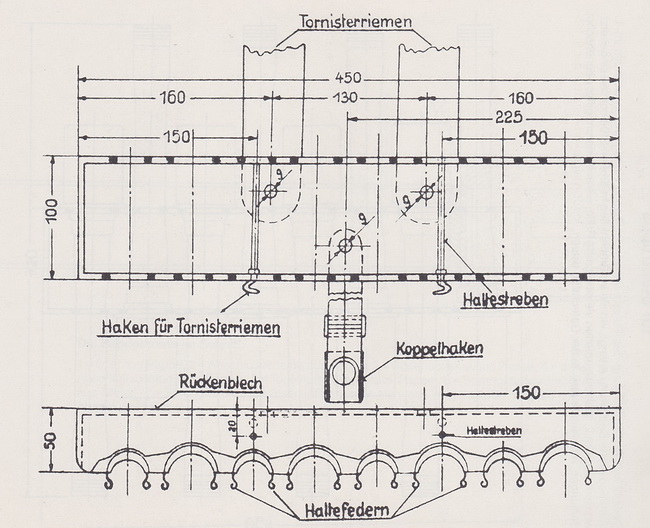
The Handgranaten-Sturmtornister was invented as an alternative to the sandbags filled with loose Stielhandgranate. Drawings were distributed by the Divisionskommandeur der 9. Infanterie Division on 30. 5. 1942. The actual production of these contraptions was meant to be done by the units themselves with help from the local Waffenmeister. An Einsatz from a standard steel transport box was cut in two and mounted on a backboard of metal. A belt hook and a pair of rucksack straps were mounted on the backboard. This would enable the soldier to carry 8 Stielhandgranate 24 into combat, especially practical when part of a "Stosstrupp" that would receive no resupply until the mission was over. They would be easy to grab when his fellow soldiers needed grenades during movement, and the grabbing and throwing of hand grenades from a concealed position when lying down would be much easier compared to the alternative of carrying them in sandbags under their arms. Proof of training To register that the individual soldier had fulfilled the necessary training to use hand grenades it was penned in on page 20 in their Wehrpaß, their file held by the unit clerk. This one simply says "Hand grenades". It doesn't specify which type he was trained with. The details of the input was up to the company clerk. This book has some more details. The penned in details read "dt. Ei u. Stielhandgranate"; German Egg and Stiel handgrenades. Trench art It is a well-known fact that soldiering is all about waiting. And some soldiers turn available time into something useful. This Stielhandgranate 24 was sold on the internet some years ago, and is a classic example of "trench art", which is defined as "any decorative item made by soldiers, prisoners of war or civilians where the manufacture is directly linked to armed conflict or its consequences". 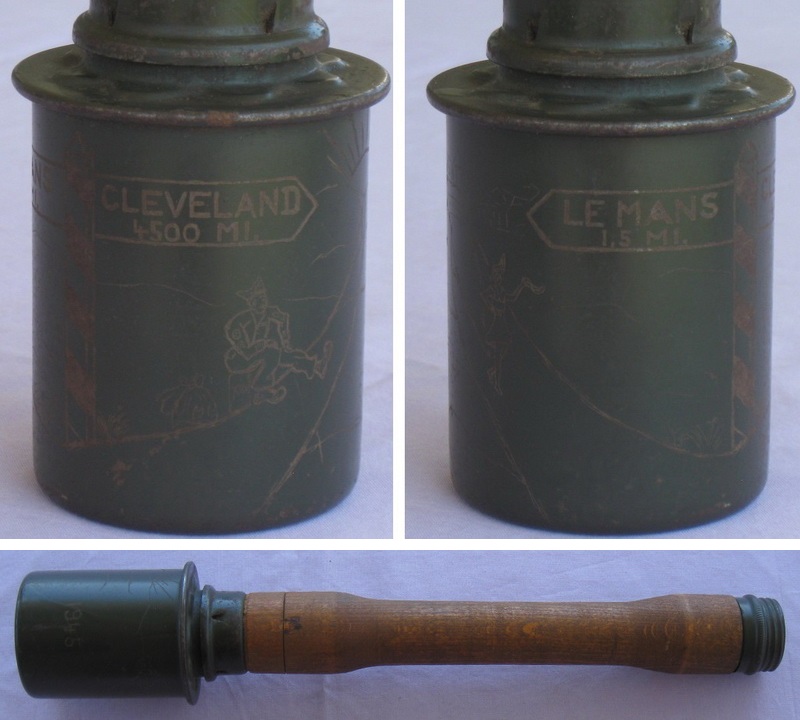 The "artist" has simply carved the motif into the paintwork of a standard Stielhandgranate 24. He was obviously stationed in France, 1.5 miles from Le Mans in 1945, and I venture a guess that he had feelings for Cleveland.... Symbolism The Stielhandgranate had a distinctive shape, and was closely associated with the German army since it was invented during the great war. Due to this it was also often used as a powerful symbol. 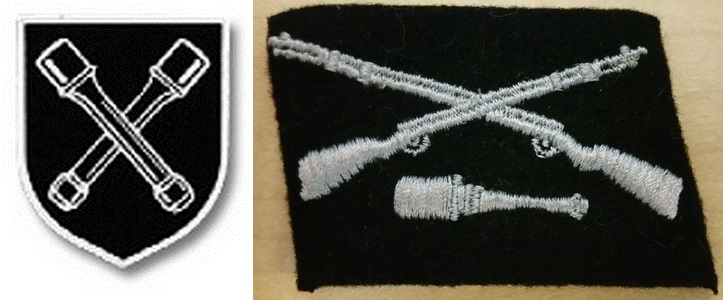 The 36th Waffen Grenadier Division of the SS, aka "SS-Sturmbrigade Dirlewanger", used a pair of crossed Stielhandgranate 24 on a shield-shaped background as their divisional insignia, and a pair of crossed rifle above a Stielhandgranate as their collar insignia.  Soldiers from SS-Sturmbrigade Dirlewanger in street fighting during the Warsaw uprising in August 1944. The soldier in front carries the collar patch shown above. Note the Stielhandgranate 24 held by the man on the right. It was also used by the 65. Infanterie-Division der Wehrmacht as a divisional insignia on vehicles, but only with a single Stielhandgranate on a shield-shaped background. 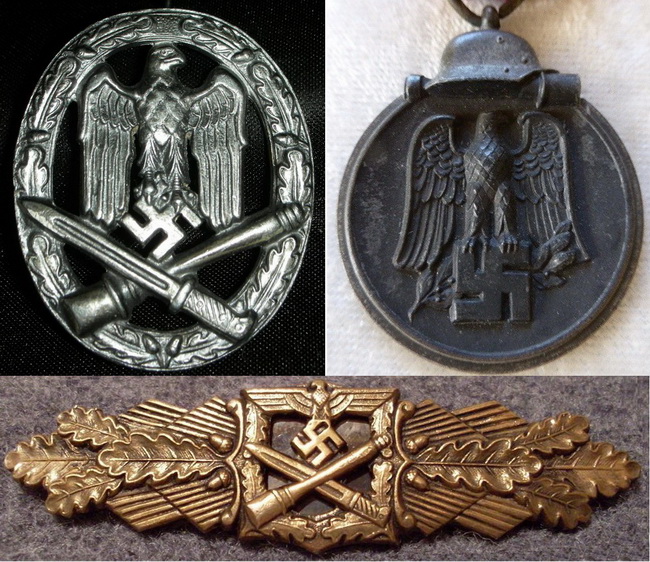 It was also used as a symbol of strength and power on awards and medals. Here it can be seen in use on the Allgemeine Sturmabzeichen, the Winterschlacht im Osten 1941/42 medal and the Nahkampfspange. "As found" The Stielhandgranate 24 still surfaces, literally, today. Those that were dumped in water both during the war and in the first years after the war are today worth enough for divers and "fishers" to salvage and empty them. Apart from the rust on the metal parts they are easy to spot by the bubbly appearance of the paintwork, and the grey wood.  A rather nice example of a "Wasserfund" (found in water) Stielhandgranate 24.  But they can even be found "in the wild". The picture above shows the author on a mountain trip in Northern Norway in 1996 sightseeing the positions held by Gebirgsjäger units in May 1945. When the war ended they simply walked down from the mountain leaving everything behind. Right below my wrist is the head of a Stielhandgranate 24. It had a hole rusted through and was empty, so I brought it along. Things like this have no commercial value in my eyes, but as a souvenir it is priceless! 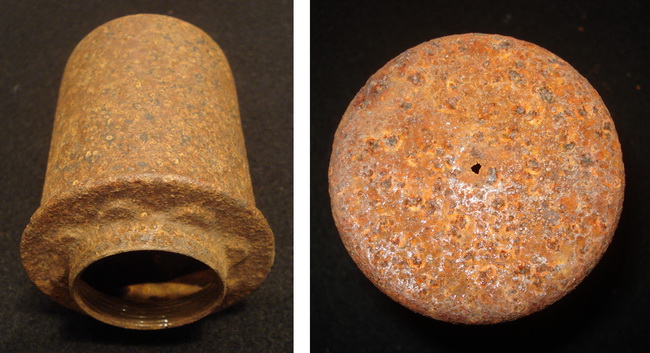 It had been lying fully exposed to the elements for 51 years but still some minor spots of paint could be found! The unsolved mystery The following info has been made available thanks to Nick Jeans, UK. At least two specimens of an unidentified version of the Stielhandgranate exist, both are cut through models. The grenade appears to be made from thicker steel, and it has a threaded plug that holds the well for the detonator.  In addition it has a hexagonal pattern pressed into the top of the can, beyond doubt for identification purposes. The manufacture of this model must have required special tooling, so it is certainly not a prototype, and still it can't be found in numbers. I haven't been able to find any mentioning of this type of grenade, so my theory is that it must have contained a chemical agent, and the complete stock must have been dumped or destroyed. This could also explain why both surviving grenades are of the instructional type, and why the detonator well is threaded (my guess is that it was for filling purposes). The explosion of the detonator would be sufficient to destroy the casing and spread the contents, without damaging it by heat.  An unidentified version of the handle has also been found. It was manufactured with deep indents to the end in order to ease identification in the dark. This handle could very well be linked with the head above, but again nothing is known for sure. |
| Home | For sale | Site map | Contact information | Guest book | Stielhandgranate 24 menu |